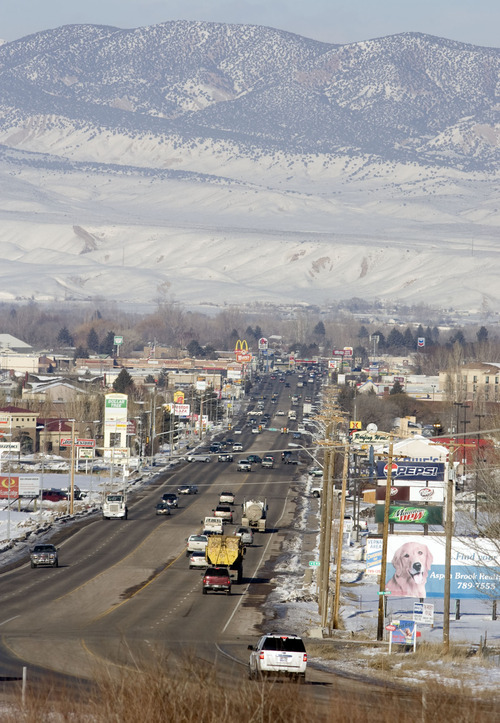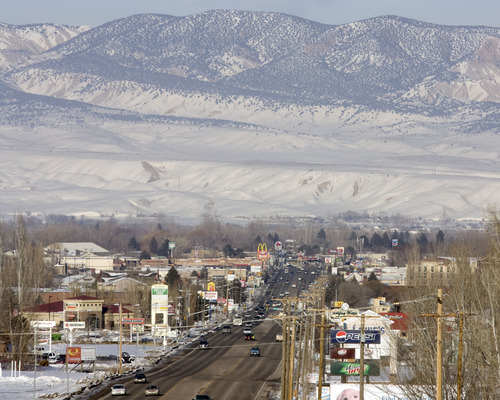This is an archived article that was published on sltrib.com in 2013, and information in the article may be outdated. It is provided only for personal research purposes and may not be reprinted.
Vernal's Main Street is now busier than Provo's wide, crowded University Avenue. Three new motels are springing up in Vernal largely to handle oil field workers and visitors — and travelers who don't make motel reservations during the week might not find a room.
"There are days that you don't want to be turning left on Main Street unless you are at a light, because the traffic is just so heavy," says state Sen. Kevin Van Tassell, R-Vernal, who is a banker there. "Yes, the growth is mostly from the oil and gas industry."
Watching that, he's not surprised that the U.S. Census Bureau announced Thursday that Vernal is the nation's fifth-fastest growing "micropolitan area," for urban clusters with populations between 10,000 and 49,999.
The Census estimates Vernal now has 34,524 residents, up 4.1 percent in a year — a rate more than five times faster than the national average.
That is part of a trend where many of the nation's fastest-growing areas last year were in oil and gas drilling regions.
For example, Midland in Texas's oil country was the fastest-growing metropolitan area (for regions with populations greater than 50,000) from July 1, 2011 to July, 1, 2012. Adjacent Odessa, Texas was fifth overall, Austin-Round Rock was seventh and two oil areas in Wyoming (Casper and Cheyenne) plus Bismark, N.D., were among the 20 fastest growing.
"No doubt the energy boom is playing a role," said Thomas Mesenbourg, the Census Bureau's acting director.
Oil drilling areas also account for many of the fastest-growing, smaller micropolitan areas. Williston, N.D., ranked first, with 9.3 percent growth. Others in the top 20 — besides Vernal — include Dickinson, N.D.; Andrews, Texas; three in western Oklahoma (Elk City, Weatherford and Woodward); and Gillette, Wyo.
As far as Vernal, Van Tassell says the boom to date might just be the beginning.
"They are just exploring now, which is the expensive part of the process. They aren't sharing the results with me, but they continue to do more exploration — which is a good sign about what may come."
But, he laments, "What may hold growth in check is our ability to move the product."
A recent study by the Utah Department of Transportation said the Uinta Basin could see huge growth in oil and gas — akin to North Dakota's current boom — except that it lacks adequate transportation to bring more oil to refineries in North Salt Lake, demonstrated by a constant parade of super tankers on highways. The Legislature has included $3 million in budgets for a study on how to solve that.
"Vernal has seen many boom-and-bust cycles, and is in another boom," said University of Utah research economist Pam Perlich. She said small areas dependent on oil or mining usually find it hard to escape such cycles unless they can diversify and attract other businesses. She adds Vernal may have started that by becoming more of a regional commercial center, serving a growing area.
Van Tassell is one who believes this boom won't go bust. "I think the growth is sustainable," he said, noting that studies foresee increasing oil and gas production for decades.
New Census data show Utah is also home to the nation's sixth-fastest growing micropolitan area: Heber City. Its population is now estimated at 25,273, up 3.8 percent in the year.
David Stringfellow, chief economist for Utah State Auditor John Dougall, said Heber acts as a sort of remote suburb of the Wasatch Front. "People there still have access to all of the amenities of the larger metropolitan area, but can also be away from it all. It's sort of a 'Park City effect' going on there."
Perlich said Heber traditionally has also been where those who work in expensive Park City can find cheaper housing.
All of Utah's other metro and micropolitan areas showed growth in 2012 — except the Price micropolitan area, where population dropped by 0.5 percent in the year.
"Coal is not a growth industry right now," Perlich said about the decline in Price, county seat of Carbon County.
The Census estimates the population in the Salt Lake metro area grew 1.5 percent; Provo-Orem grew 1.9 percent; Ogden-Clearfield, 1.1 percent; St. George, 2.3 percent; and Logan, 0.7 percent.
For other micropolitan areas, Cedar City had 0.2 percent growth and Summit Park (near Park City) had 1.5 percent growth.
Most of that growth was above the 0.75 percent national average.
Perlich said most of the growth is from Utah's high birth rate, but some also comes from a strong economy attracting immigrants.Stringfellow also noted the employment draw, adding, "Utah is still experiencing the second fastest [job] growth in the country at 3 percent."





